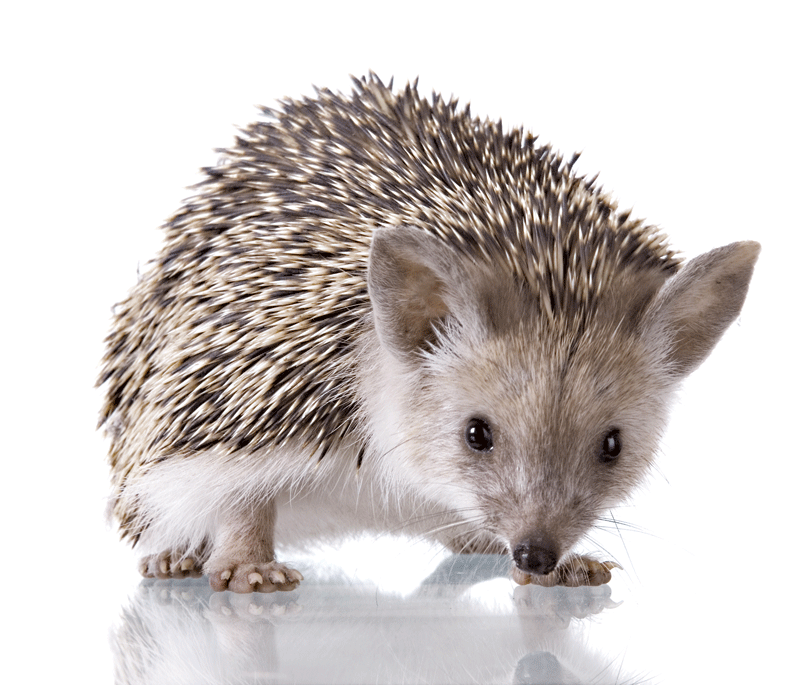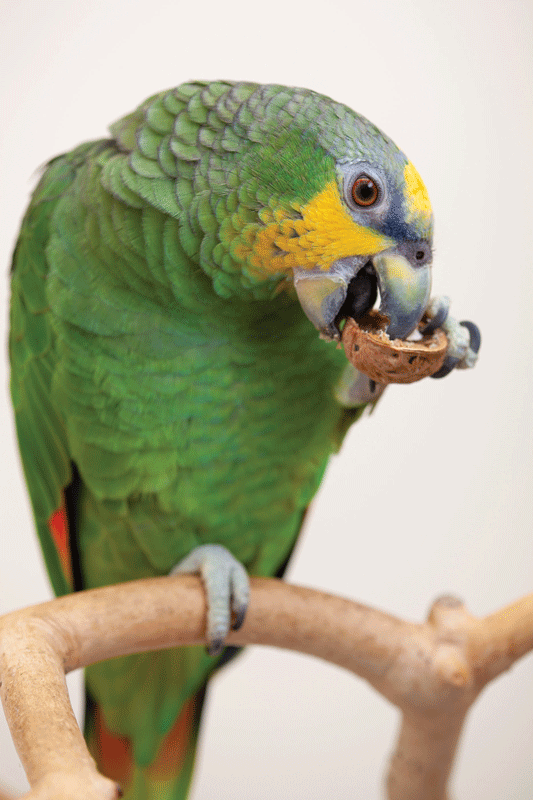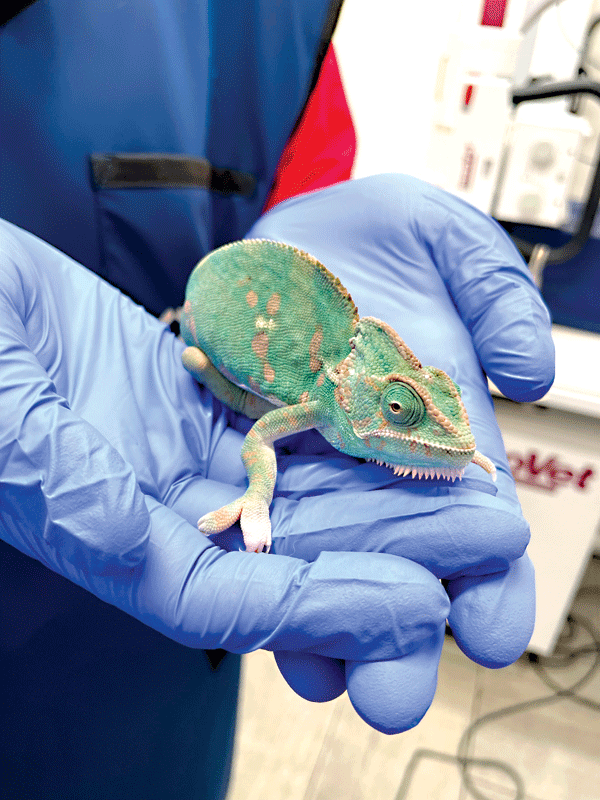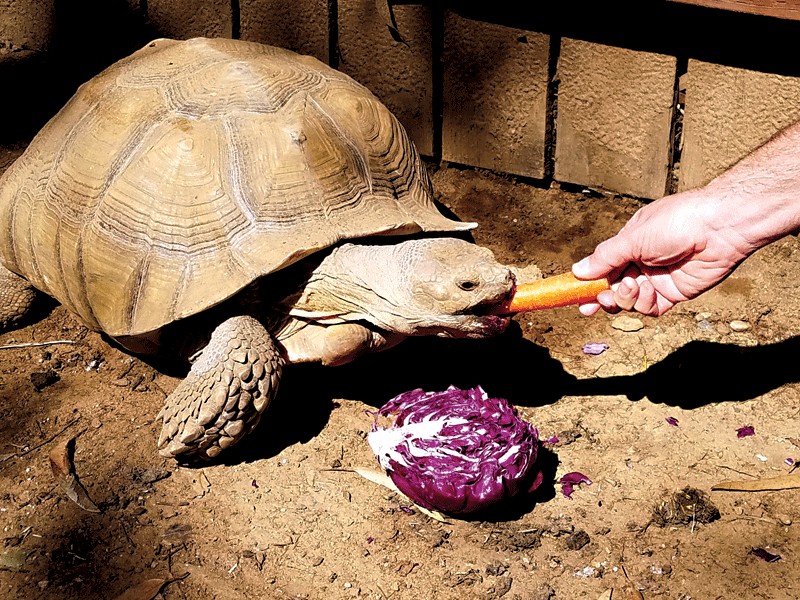
Exotic pets have grown in popularity over the years and can be found in about 18 million households in the United States.1 While birds, reptiles, and a variety of furry animals can fall into this one classification of pets, the nutritional needs of these individual species are not all the same.
Veterinary professionals should be able to guide pet owners in providing appropriate foods at home for their unique pets, but they should also be prepared to meet the nutritional requirements of these animals if they become in-patients.
Similar to dogs and cats, specific vitamins, minerals, proteins, and other nutritional components are needed for exotic pets, which, if not met, could lead to serious health problems.
Knowing what a specific species should eat versus what the pet is being fed and consuming at home can help identify an underlying reason for an exotic pet’s illness. Nutritional needs should not be ignored, especially if a sick exotic pet is not consuming enough calories to meet its daily energy requirements on its own.2
Understanding exotic pet species
The majority of exotic or nontraditional pets are often called pocket pets or exotic companion animals. Domesticated farm animals, dogs, and cats are typically excluded from the pocket pet and exotic companion animal classifications, but rabbits, potbellied pigs, and some other farm animals may be considered exotic pets, too.
This grouping includes common small mammals, such as rabbits, guinea pigs, hamsters, and ferrets. Hedgehogs, sugar gliders, chinchillas, degus, skunks, flying squirrels, fennec foxes, and many other furry critters can also fall under these classifications.
Nutritional needs of the animals within this grouping vary greatly and may include meat, insects, fruits, and vegetables. Many of these pets need food available at all times since they have very fast metabolisms and benefit from a variety of food items.
Birds make up the next largest group of exotic pets.1 From chickens to finches to macaws, these feathered pets vary greatly in size and nutritional needs, especially if they lay eggs. Despite their nutritional deficiencies, seeds often make up a portion of many avian diets. Depending on the species, pre-formulated pellets, fruits, vegetables, insects, and other items should instead be offered to pet birds. Pet birds typically always need food available due to their fast metabolisms.
Reptiles are found in about six million households, and similar to other types of exotic pets, there are a variety of species within this grouping. The different pet snakes, lizards, turtles, and tortoises may eat fruit, vegetables, insects, and even meat. Many species do not eat on a daily—or even weekly—basis, so being aware of what a specific reptile eats, along with how often they eat, is important.
Other exotic pets that do not commonly fall into these three classifications, such as arachnids, snails, and amphibians, also exist and have their unique nutritional requirements. It is uncommon for these species to be hospitalized, but being familiar with what the proper in-home care should be is still beneficial for veterinary professionals.

Common nutritional challenges
Since complete and balanced, preformulated diets are widely available for dogs and cats, unless they are eating a homemade diet, nutritional deficiencies and imbalances are not as commonly seen in these species compared to exotic pets.
Exotic pet owners do not always have the luxury of purchasing a bag or can of complete and balanced food to feed their pet, so they may need to provide a variety of food items and supplements to ensure the diet is balanced. Preparing daily meals of different fruits, vegetables, calcium supplements, proteins, and other items for various animals is not uncommon for exotic pet owners, so they need to be aware of which items contain the most appropriate levels of nutrients and avoid the ones that could make their pets sick. For example, avocado is widely considered toxic for birds.
If exotic pets do not consistently consume all the necessary ingredients they need in the appropriate amounts, a variety of health issues can develop. To further complicate matters, ultraviolet B (UVB) lighting can be important in vitamin D synthesis in several exotic pet species.2 This means discussing what a pet is eating and what kind of lighting they are exposed to daily may help uncover underlying reasons for nutritional concerns.
An inappropriate diet can cause a variety of diseases, as well as skin, coat, shell, beak, or feather changes, and require veterinary attention.

Diagnostic approaches in the veterinary hospital
The at-home care an exotic pet receives is vital to its overall health and well-being. Depending on the type of exotic pet, specific housing, heat, lighting, humidity, and substrates may be necessary in addition to proper nutrition. If an exotic pet receives inappropriate nutrition, vitamin and mineral deficiencies or imbalances can occur and may result in serious medical conditions or even death. Due to this, a thorough patient history, including nutrition, should be obtained at each veterinary visit.
This nutritional evaluation is often referred to as the fifth vital sign because of its importance in the health and well-being of pets.3 As with dogs and cats, all of the information obtained from the exotic pet’s history should be used alongside the physical examination findings to assess the patient’s overall health and well-being and determine what diagnostic tests should be performed. If after the physical examination a veterinary professional is unsure how to appropriately assess an exotic pet’s body condition score, resources compiled by the Nutrition Advisory Group to the Association of Zoos and Aquariums can be referenced for various species.4
Diagnostic tests may include bloodwork, fecal analysis, and radiographs. Routine bloodwork is recommended for many exotic pets to establish a normal baseline for that individual animal and to check for abnormalities, even if the patient appears to be healthy.
Abnormal calcium levels, kidney and liver disease, anemia, and other findings can indicate nutritional deficiencies and warrant further testing. A fecal analysis can rule out intestinal parasites if inappropriate nutrition is a suspected cause of diarrhea.
Finally, radiographs can evaluate bone density, check for fractures, and visualize uroliths if calcium is of a concern.
Feeding hospitalized exotic pets
If an exotic pet needs to be hospitalized, dietary needs must not be forgotten. Patients scheduled for surgery may need to be fasted, which is generally much shorter than those of dogs and cats and will also vary between species.
If surgery is not needed, food should be provided to the patient as it would be at home. If the pet owner can bring food from home for their hospitalized pet, this will provide a level of familiarity and comfort to your patient. Some exotic pets can be finicky eaters, so having the same food they eat at home also helps to increase the likelihood that they will eat while in the hospital.
Exotic pets that are hospitalized for nutritional concerns may have been receiving an inappropriate diet at home. In these cases, the food the patient receives at home should still be brought into the hospital, but other foods and supplements may need to be mixed into it. This may help to make the diet complete and balanced, treat diagnosed nutritional deficiencies, or wean a patient off any items they should not have been eating in the
first place.
It is important to ensure a patient does not stop eating for an extended period of time, both at home and in the hospital. However, if a patient refuses to eat while hospitalized, assisted feeding may be necessary. If assisted feeding is necessary and the patient has not been eating for an extended period of time, veterinary professionals should be aware of and monitor for signs of refeeding syndrome.5
Additionally, caution should be taken with syringe and tube feeding to ensure aspiration does not occur, especially in small exotic pets. With many exotic pets, providing appropriate humidity and temperature in the environment can increase the likelihood of them eating on their own. Because of this, these husbandry factors should not be ignored even if a patient
is hospitalized.6
Further, a variety of liquified foods can be stocked in the hospital and used for different species of exotic pets. Ideally, a food formulated with all the essential nutrients of a complete and balanced diet for the specific species should be used. These pre-formulated products are available to purchase as powders and finely ground hays. They are mixed with water to create a gruel that can then be syringe- or tube-fed to a patient, but they can also be used as food toppers to entice exotic pets to eat on their own.
If these specialized products are not available, pureed baby foods can temporarily be used since they are easily administered through a syringe, but they are not complete and balanced foods and therefore should not be long-term solutions.

Nutritional management and monitoring
Exotic pets that have had nutritional concerns will benefit from ongoing monitoring to ensure any noted health issues have been corrected. Part of this monitoring should include regular weigh-ins to help confirm whether they are eating the appropriate amount of food.
Additionally, a diet history should continue to be obtained at each visit to ensure a patient continues to receive an appropriate diet if previous alterations were needed.
If abnormalities were noted in the initial blood work or radiographs, these tests should be repeated to confirm improvement or resolution, as well as monitor for recurrence.
Several health issues can be avoided with optimal dietary care and this care is both important for pet owners to provide at home, and for veterinary professionals to provide in the hospital. If veterinary professionals are not aware of how to advise pet owners in feeding their pets, or how to provide appropriate nutrition in the hospital, patient care can suffer. While significant scientific research on the exact nutritional needs of all exotic pet species may not be available, there are numerous reputable resources that provide varying levels of insight into their dietary care.7
Veterinary journals, online articles, print publications, continuing education programs, and much more exist for veterinary professionals looking to expand their knowledge of exotic pet nutrition.
Adrienne Kruzer, BBA, RVT, LVT, is a credentialed veterinary technician in Ohio, NC, and South Carolina. Kruzer writes for various publications, lectures at veterinary conferences and colleges across the U.S., and currently works for Veterinary Emergency Group as the veterinary nursing program manager. She also volunteers her time as a district representative and board member for the South Carolina Association of Veterinary Technicians and actively represents her profession on social media.
References
- MarketWatch – Guides. “Top Pet Ownership Statistics and Facts (2024).” Accessed August 25, 2024. https://www.marketwatch.com/guides/pet-insurance/pet-ownership-statistics/.
- Watson, Megan K., and Mark A. Mitchell. “Vitamin D and Ultraviolet B Radiation Considerations for Exotic Pets.” Journal of Exotic Pet Medicine 23, no. 4 (October 2014): 369–79.
- Freeman, Lisa, Iveta Becvarova, Nick Cave, Clayton MacKay, Patrick Nguyen, Betina Rama, Gregg Takashima, Ross Tiffin, Peter van Beukelen, and S Yathiraj. “WSAVA Nutritional Assessment Guidelines.” Journal of Feline Medicine and Surgery 13, no. 7 (July 2011): 516–25.
- “Body Condition Scoring Resource Center • AZA Nutrition Advisory Group.” Accessed August 28, 2024. https://nagonline.net/3877/body-condition-scoring/.
- Latney, La’Toya V. “Nutritive Support for Critical Exotic Patients.” Veterinary Clinics of North America: Exotic Animal Practice 26, no. 3 (September 2023): 711–35.
- Leung, Y. Becca. “Assisted Enteral Feeding of Exotic Companion Animals.” Veterinary Clinics of North America: Exotic Animal Practice 27, no. 1 (January 2024): 115–34.
- Briscoe, Jeleen A., La’Toya Latney, and Cailin R. Heinze. “Nutritional Support in Exotic Pet Species.” In Nutritional Management of Hospitalized Small Animals, edited by Daniel L. Chan, 1st ed., 234–46. Wiley, 2015.
